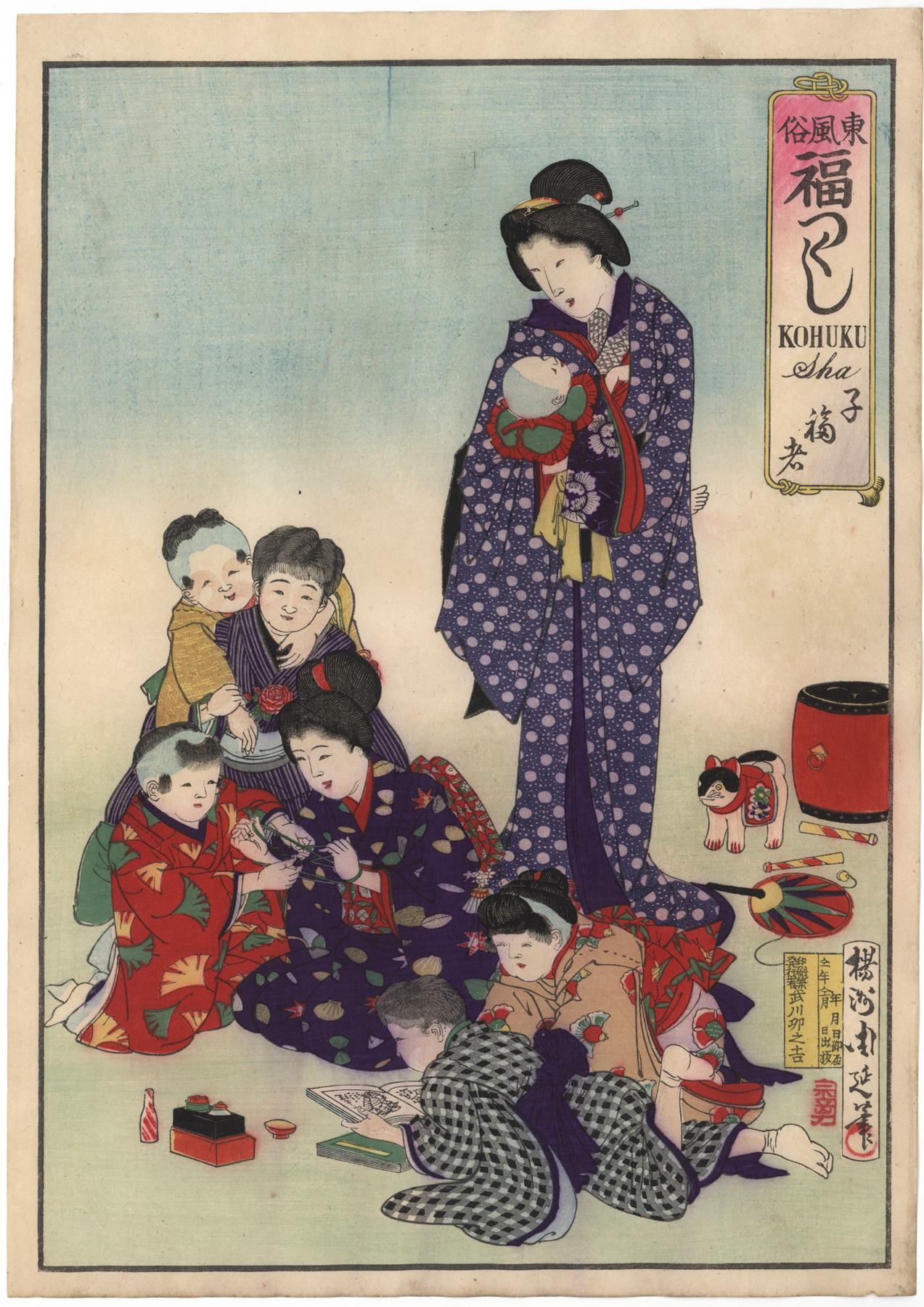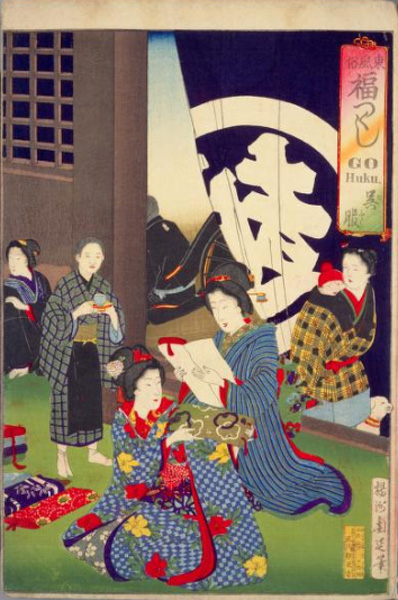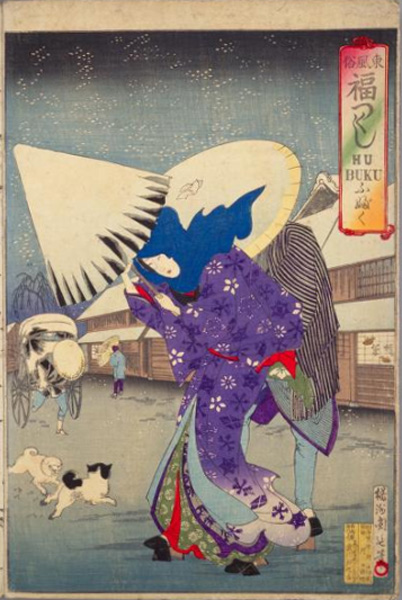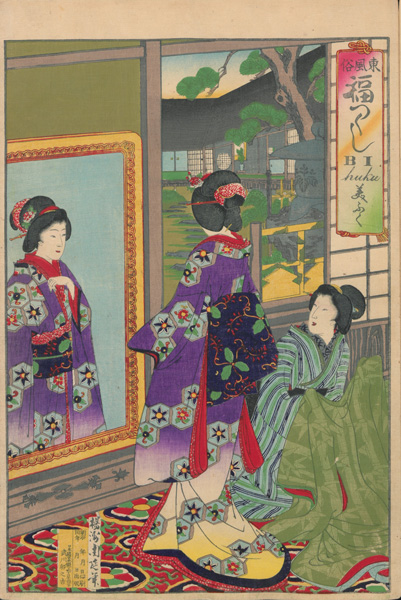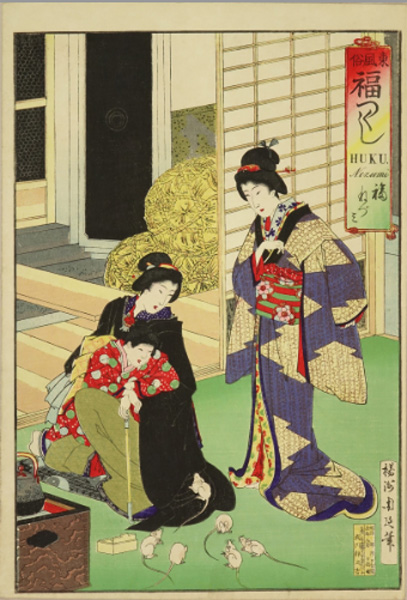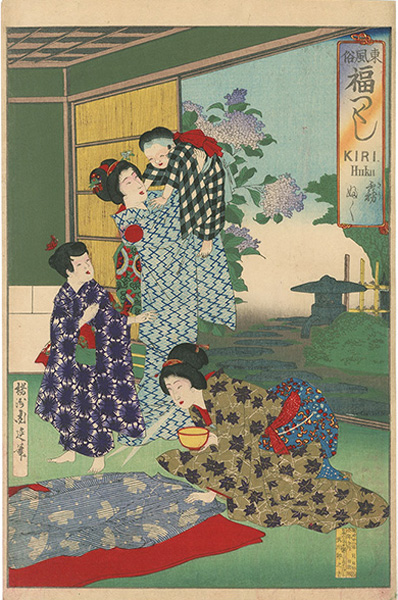About This Print
Seven children are shown amidst toys, games and books. Two girls play ayatori ("string pulling") or cat's cradle, while a young lad looks at pictures of samurai ("warriors"). An inu haiku (papier mache dog) is at right, next to a fan, drum and drumsticks. In the foreground is a miniature sake (rice wine) set for pretend parties. The whole group looks well-fed and happy, although the mother seems rather tired from managing such a crew.2
1 This series has been variously translated as Eastern Customs: Varieties of Happiness; Customs of Tokyo, A Collection of "Fuku" Words; Customs of the East, A Collection of Fuku Words; An Array of Auspicious Customs of Eastern Japan; Customs of Edo: Enumerated Fortunes; Customs of the Capital Displayed by Homonyms of the Word "Fuku"; Collection of Happiness, Daily Life of the East; A Collection of Happiness, Customs in the East among others.
2 Chikanobu: Modernity and Nostalgia in Japanese Prints, Bruce A. Coats, Hotei Publishing, 2006, p. 142.
The Series Eastern Customs: Enumerated Blessings
Source: Chikanobu: Modernity and Nostalgia in Japanese Prints, Bruce A. Coats, Hotei Publishing, 2006, p.46 and my commentary."Some of these single sheet designs [in the series Eastern Customs: Enumerated Blessings] are among Chikanobu's finest renderings of Meiji period life, with elegant modern ladies dressed in the latest French fashions and handsome government officials donning their European style uniforms. He also created vignettes of daily life at home in Tokyo, with a baby learning to crawl, children playing games, young girls reading in the afternoon, and two young women enjoying flute music at dusk in an iris garden.
These images have a proud sense of well being, that Japan has successfully transitioned into the modern era but still retained the best aspects of its traditional culture. The Roman alphabet has been used in titles to give a contemporary global outlook to the prints, even though the letters spell Japanese words. These works were published at a time when discussions were taking place in Tokyo about whether Chinese characters (kanji) should be abandoned as too old fashioned and cumbersome, and how English should become more widespread in Japan as a way of making the Japanese more internationally conscious and competitive."
Each print carries one of the many meanings of the word "fuku" (or "huku" as it appears in each print's multi-colored title cartouche, written in a hybrid form of Western fonts.)
Many of the prints in the series, if not the entire series, were issued more than once, as color variants of many of the prints exist and varying dates of publication can be found on several prints. In addition, many of the prints in the series can be found both with dates in the publisher's rectangular cartouche or without dates.
The Thirty Prints in the Series
Note: Most of the below images were taken from the bound album in the collection of the National Diet Library, with other images coming from the bound album in the collection of the Metropolitan Museum of Art and the prints in the collection of Keio University Library. When multiple dates are shown below, it reflects that different copies of a particular print bear different dates.
| 福引 (ふく引) Lottery, 1889 “HUKU BIKI.” | 福わらひ (福わらい) Lucky Laugh Game, 1889 (Fukuwara Game) ”HUKU Warai.” | ふくわうち (福は内) Inside Happiness, 1887, 1889 “HUKU Wauthi” | 福寿草 Pheasant-eye, 1890 “huku Giusoii” |
| 馥郁 Fragrance, 1889 “HUKU IKU” | けんふく Two Mirrors Looking, 1890 “Ken huku” | 双幅 A Set of Hanging Scrolls, 1889 (Two Kakemonos) "SOU HUKU.” | 万民きふく Allegiance of Everybody, 1889 “BANMIN kihuku” |
七福まうで Visiting the Shrines of the Seven Lucky Gods, 1889 "7 Huku Maude.” | 風ふく Wind Blowing, 1889 "KAZE huku" | ふくろう Owls, 1889 “HUKU RO” | 紙ふく Paper Blowing, 1890 “KAMI-HUKU.” |
| 笛ふく Blowing a Flute, 1889 “huye Huku.” | ふくりん Ornamental Border, 1887, 1890 “HUKU RIN”* *a type of flower | ふくべ Gourds, 1890 “huku be” | へんふ Bats, 1887 and 1889 "hen HUKU" |
| 子福者 Blessed with Many Children, 1890 “KOHUKU Sha” | 妾ふ Concubine's Children, 1890 "SHO HUKU" | 匍匐 (葡匐) Crawling, 1889 "HO HUKU" | 有ふく (有福) Wealthy, 1890 "YUU huku" |
| ふく写 Photographs, 1890 "HUKU SHA" | ふく神 (福神) God of Fortune, 1890 ”Huku Gin” | ふくどく Supplementary Reading, 1887, 1889 “HUKU Doku” | 呉服 Kimono fabrics, 1887, 1889 "GO Huku" |
ふぶく Blizzard, 1889"HU HUKU" | 洋ふく Western Clothing, 1889 "YOU Huku " | 大 礼ふく(大札ふく) – Ceremonial Attire, 1889 (Official Clothes) ”TAIREI HUKU” | 美ふく Fine Dress, not dated “BI huku” |
福ねずみ (福ねづみ) Lucky Mice, not dated “HUKU Nezumi" | 霧ふく Spraying Water, 1889 "Kiri huku" |
Print Details
| IHL Catalog | #2210 |
| Title or Description | Blessed with Many Children 子福者 kofuku sha |
| Series | Eastern Customs: Enumerated Blessings 東風俗 福づくし Azuma fūzoku, fukuzukushi [also seen translated as Eastern Customs: Varieties of Happiness; Customs of Tokyo, A Collection of "Fuku" Words; Customs of the East, A Collection of Fuku Words; An Array of Auspicious Customs of Eastern Japan; Customs of Edo: Enumerated Fortunes; Customs of the Capital Displayed by Homonyms of the Word "Fuku"; Collection of Happiness, Daily Life of the East; A Collection of Happiness, Customs in the East] |
| Artist | Yōshū Chikanobu (1838-1912) |
| Signature |  |
| Seal | Toshidama seal (shown above) |
| Publication Date | 1890 Meiji 22 note: printing and publication dates are not filled in on the publisher's cartouche on this collection's print (see below) but other extant prints bear the date Meiji 23 |
| Publisher | 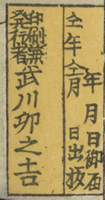 [Marks: pub. ref. 522; seal not shown] |
| Carver |  宗岡刀 Muneoka tou (Muneoka Shinkichi) 宗岡刀 Muneoka tou (Muneoka Shinkichi) |
| Impression | excellent |
| Colors | excellent |
| Condition | good - minor soiling |
| Genre | ukiyo-e |
| Miscellaneous | |
| Format | ōban |
| H x W Paper | 13 15/16 x 9 3/4 in. (35.4 x 24.8 cm) |
| H x W Image | 13 1/8 x 9 1/8 in. (33.3 x 23.2 cm) |
| Literature | Chikanobu: Modernity and Nostalgia in Japanese Prints, Bruce A. Coats, Hotei Publishing, 2006, plate 163, p. 142. |
| Collections This Print | Digital Collections of Keio University Libraries 023 261; National Diet Library Call Number 寄別8-5-2-2 (25 prints in the series bound into an album); Metropolitan Museum of Art 2007.49.331a, (26 prints in the series bound into an album); Ruth Chandler Williamson Gallery, Scripps College SC98.4.43; Boston University Arts Galleries |
last revision:
2/9/20 created


